You can find woodpeckers everywhere around the world. Although they differ in appearance and behavior, these birds are common and easy to spot and identify.
If you live in Colorado and birdwatching captivates you, this is the article for you!
After all, the breathtaking state is home to many woodpeckers and sapsuckers. Let’s dig in with 12 of the prettiest woodpeckers in Colorado.
Spotting Woodpeckers in Colorado
Considering Colorado has many wooded areas, it attracts wildlife. As a plus, many woodpeckers can be found in public parks and bird feeders.
This is great news for birdwatchers!
After all, there are many places to spot woodpeckers. Here’s a list of 12 drummers to keep an eye out for:
1. Hairy Woodpecker

- Scientific Name: Leuconotopicus villosus
- Length: 7.1 – 10.2 inches
- Weight: 1.4 – 3.4 oz
- Wingspan: 13.0 – 16.1 inches
Hairy Woodpeckers can be found around all year, not only in Colorado but also in the majority of the United States.
They’re frequently confused with Downy Woodpeckers. However, you can tell them apart by the peaks. The Downy Woodpeckers exhibit short, pointy beaks.
Meanwhile, the bill of the typical Hairy Woodpeckers is substantially longer and sturdier than the birds’ heads.
Author Note: Their diet, much like other woodpeckers, consists of insects, berries, seeds, and nuts. They can also feed on sap or suet from bird feeders in backyards.
You can find these woodpeckers from water level and up in the highlands. They do, however, prefer coniferous and deciduous woodlands.
2. Downy Woodpecker
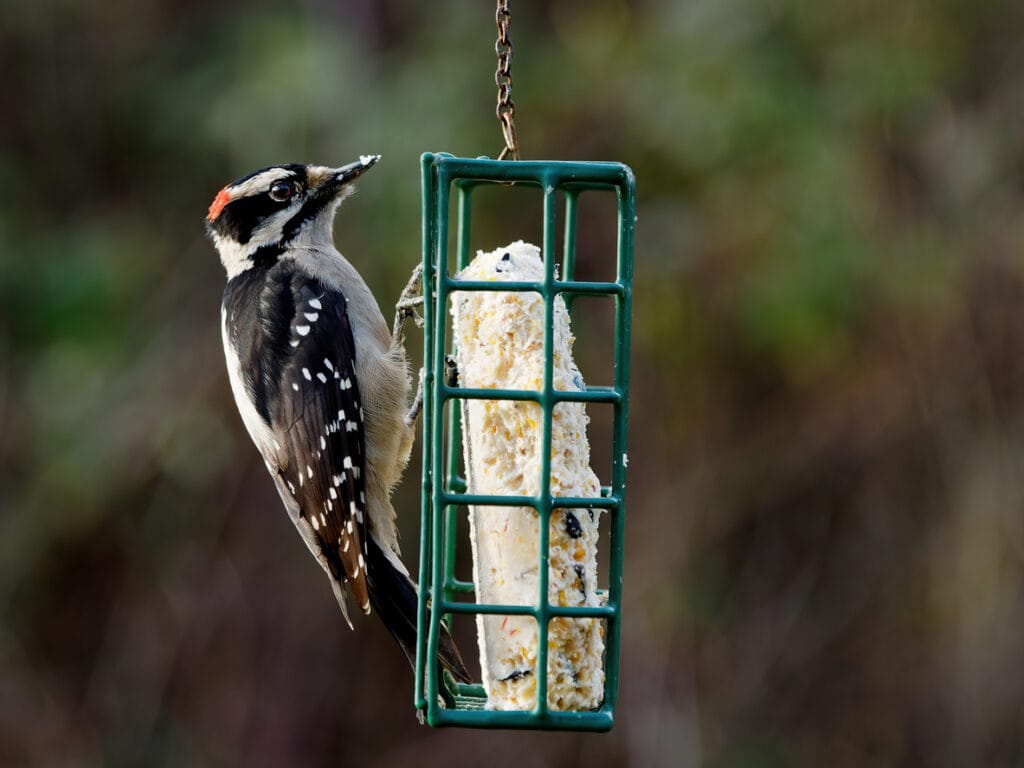
- Scientific Name: Picoides pubescens
- Length: 5.5 – 6.7 inches
- Weight: 0.7 – 1.0 oz
- Wingspan: 9.8 – 11.8 inches
Downy Woodpeckers are the smallest of Colorado’s woodpeckers. They’re even a little smaller than the average Hairy Woodpecker.
The wings of the Downy Woodpecker are mostly dark. However, they have a characteristic white back, neck, and abdomen, as well as light dotting on their wings.
You can spot them throughout the year in open forests. They can also be in public parks, gardens, and lawns, especially around bird feeders.
During the winter, the males and females separate because their diets are different. The females eat big twigs and trunks. On the other hand, the males prefer smaller branches and weed stems.
3. Red-Headed Woodpecker
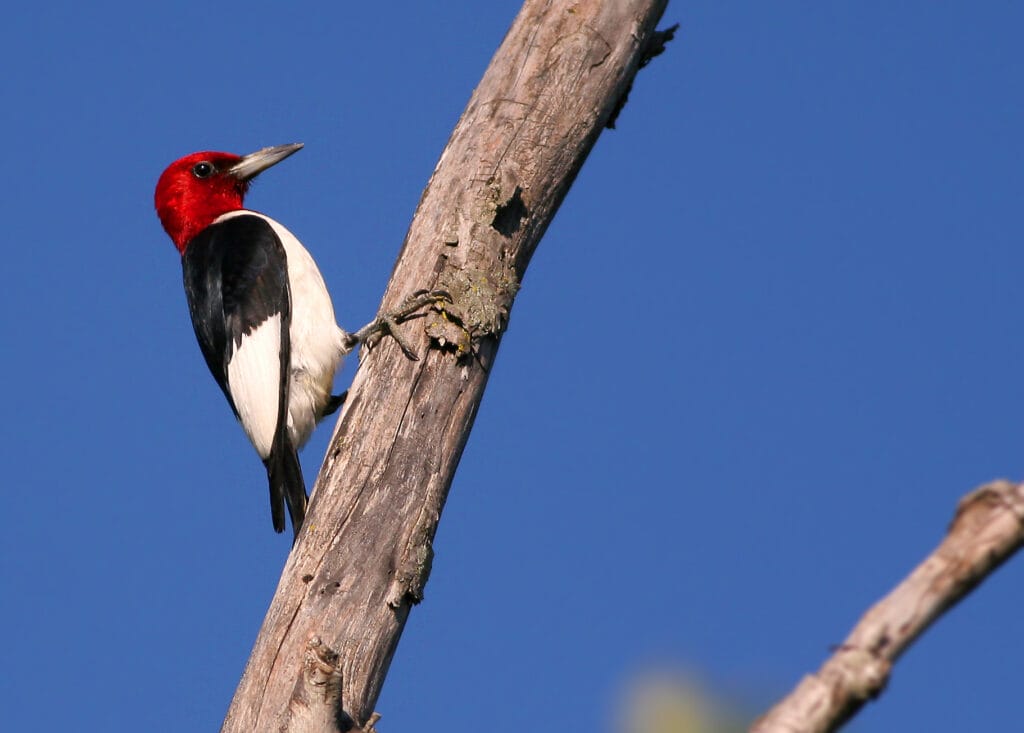
- Scientific Name: Melanerpes erythrocephalus
- Length: 7.5 – 9.1 inches
- Weight: 2.0 – 3.2 oz
- Wingspan: 16.5 inches
The Red-Headed Woodpecker is a medium-sized woodpecker that resides in North America. These magnificent creatures were once widely distributed all over the States.
Sadly, in many areas, they’re now scarce and regional. Although their population is declining, they’re still rated as Least Concern.
The woodpeckers have dark backs and tails. This dark pigmentation is contrasted with a white abdomen and red heads.
With this vibrant coloration, it would be hard to imagine that until they’re around 12 months, they tend to have brown heads. This often causes people to mistake them for another species.
You can spot this glorious woodpecker in woodlands and inhabited regions. They only have a breeding range in Eastern Colorado, but they’re common throughout the Rocky Mountains.
When the birds are hungry, they can grab flying insects, which is quite a fascinating skill when you think about it!
They also tend to store insects in tree bark to feed on them whenever necessary.
4. Red-Bellied Woodpecker

- Scientific Name: Melanerpes carolinus
- Length: 9.4 inches
- Weight: 2.0 – 3.2 oz
- Wingspan: 13.0 – 16.5 inches
Red-bellied Woodpeckers are only present in Colorado’s northwestern region, making them a rather rare species. They breed in the eastern United States, with populations stretching from Florida to Canada.
There are a few interesting things about their appearance, though.
Their face and rump are mostly light gray. Their back, wings, and tail likewise exhibit unmistakable black and white striped markings.
Because of the bright orange-red crown, they’re often mistaken for the Red-Headed Woodpecker.
Author Note: Many Eastern woodlands and forests are home to Red-Bellied Woodpeckers. These bad boys can also pop up on bird feeders as well.
Like most other woodpeckers, they also use tree cavities to store food.
5. Lewis’s Woodpecker

- Scientific Name: Melanerpes lewis
- Length: 2 – 11 inches
- Weight: 1 – 4.9 oz
- Wingspan: 3 – 20.5 inches
Lewis’s Woodpecker was named after Meriwether Lewis, who discovered this bird back in 1805.
With a dash of daring colors, these birds have a dark green back, a pink chest, and a gray neck. Their wings are substantially wider than other woodpeckers, which makes for quite the sight as they soar slowly.
Ironically enough, woodpeckers love to hunt and eat in a manner similar to crows rather than woodpeckers. They feed on flying insects caught in mid-air or plucked from a limb or tree stump.
During the colder seasons, these woodpeckers stock nuts and grains in the cavities of trees.
In most parts of Colorado, you can see Lewis’s Woodpeckers all year if you look in dense trees and heavily forested areas.
6. Northern Flicker

- Scientific Name: Colaptes auratus
- Length: 11.0 – 12.2 inches
- Weight: 3.9 – 5.6 oz
- Wingspan: 16.5 – 20.1 inches
The Northern Flicker is a medium-sized bird that resides throughout North America.
Spotting them is not all that challenging with their speckled underbelly, black collars, red napes, and yellow tails.
This species of woodpecker is one of the few that migrates. They move down south for the winter, leaving the northern regions of their territory to escape the cold.
Generally, they prefer to live in forests and woodlands, but they might be seen around parks and suburbs throughout the city.
By now, you can probably tell that Northern Flickers aren’t your average woodpeckers.
They forage on the ground, occasionally with sparrows and blackbirds. Their primary food source is insects that they catch from the soil. Yet, they won’t snub from eating fruits, and seeds, particularly throughout the winter when the bug population is declining.
7. Red-Naped Sapsucker

- Scientific Name: Sphyrapicus nuchalis
- Length: 7.5 – 8.3 inches
- Weight: 1.1 – 2.3 oz
- Wingspan: 16.1 – 16.9 inches
Red-Naped Sapsuckers are well-known for their sugar craving. They’re medium-sized woodpeckers that reside mainly in North America. You can spot them during the breeding season throughout the midwest areas of Colorado.
Originally, they were classified as a Yellow-Bellied Sapsucker subtype. Now, they’re recognized as a stand-alone species.
Their identification is fairly easy with a red crown, nape, and collar. This bold redness stands out from an overall black-and-white themed body.
It’s also worth mentioning that male Red-Naped Sapsuckers have a red jawline, while females have a white patch.
Despite what the name might suggest, these birds don’t suck sap. Instead, they sip it using the tip of their tongues. To get the most out of every sip, their tongues have little hair-like threads that assist keep the sap in place.
Author Note: To supplement their diets, they also feed on several kinds of insects and fruits.
During the winter, these birds like to stay in wooded areas. As for the summers, they prefer to reside in mixed forests in the mountains.
8. American Three-Toed Woodpecker
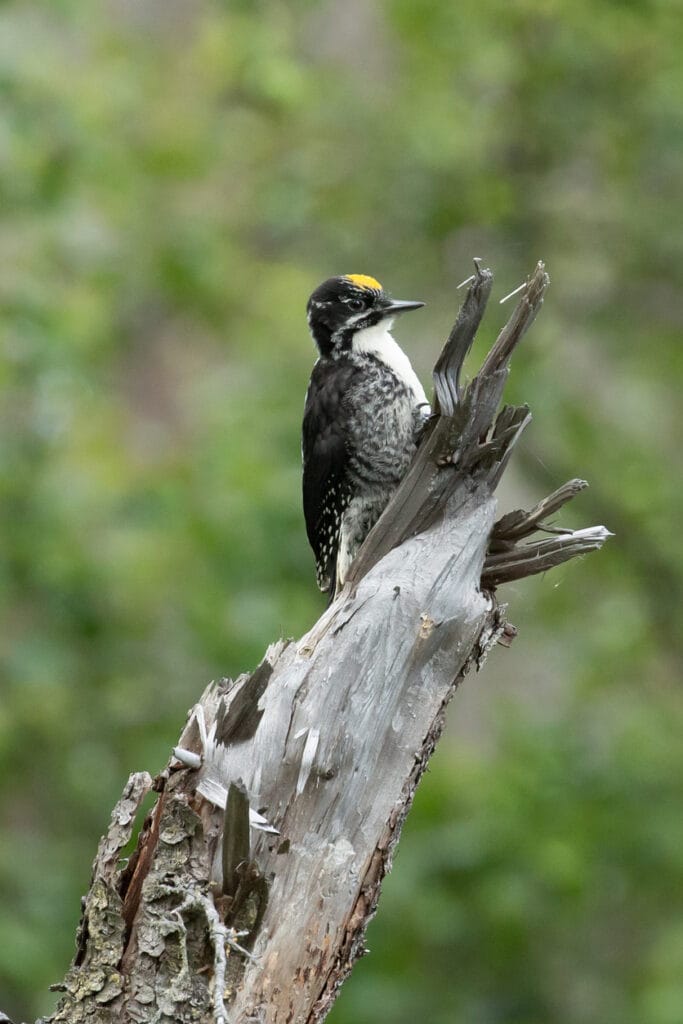
- Scientific Name: Picoides dorsalis
- Length: 8.3 – 9.1 inches
- Weight: 1.6 – 2.4 oz
- Wingspan: 14.6 – 15.3 inches
North America is home to the Three-Toed Woodpeckers that are mostly spotted in central Colorado around the Rocky Mountain woodlands.
Instead of the zygodactyl toes, these birds have only three toes, hence the name. It’s unusual for woodpeckers to have that feature.
However, it appears to give them an edge as hunters. Thanks to their odd toes, they can recline back, attack, and claw their prey with a strong strike.
Appearance-wise, they aren’t as vibrant as other woodpeckers. They have a yellow spot on their forehead. With the exception of that spot, they’re mostly black and white. This renders their appearance a bit bland.
Yet, their look allows them to hide in the forests and mountain terrain where they could blend well with damaged trees.
9. Yellow-Bellied Sapsucker

- Scientific Name: Sphyrapicus varius
- Length: 1 – 8.7 inches
- Weight: 5 – 1.9 oz
- Wingspan: 4 – 15.8 inches
The Yellow-Bellied Sapsucker resides in Canada and the northeastern parts of the United States.
Although they can be occasionally spotted in Colorado, they aren’t common there. They’re more prone to come down south during the wintertime to avoid the cold.
Yellow-Bellied Sapsuckers are mostly black and white with striking patterned faces. However, their scarlet foreheads are their most distinguishing quality.
In their territorial drumming, the Yellow-Bellied Sapsuckers often exploit human-made items. They can enhance the drumming by using metal poles on the street. Though the metal may seem harmful to the birds, it doesn’t affect their bills.
Top Tip: As the name implies, their nutrition consists primarily of sap. They won’t mind eating berries, fruits, and insects, though!
They prefer living in clusters of small trees in growing forests than in thick forests. It’s the open canopy that attracts them. They also tend to spend their winters in open woodlands.
10. Williamson’s Sapsucker

- Scientific Name: Sphyrapicus thyroideus
- Length: 8.3 – 9.8 inches
- Weight: 1.6 – 1.9 oz
- Wingspan: 17 inches
The Williamson’s bird is the biggest sapsucker. They usually nest in Colorado during their summer breeding season.
Both sexes have distinct appearances. The males have a black body with a crimson neck, a yellow abdomen, and white wing markings.
The female is mostly black with a faded yellow chest. Originally, the female was classified as a separate species because of the visual differences. They went under the black-breasted woodpecker.
Williamson’s Sapsuckers are mostly seen in the Rocky Mountain woods. Despite the cold, they tend to stay in the same habitat during the winter, although at a lower altitude.
11. Ladder-Backed Woodpecker
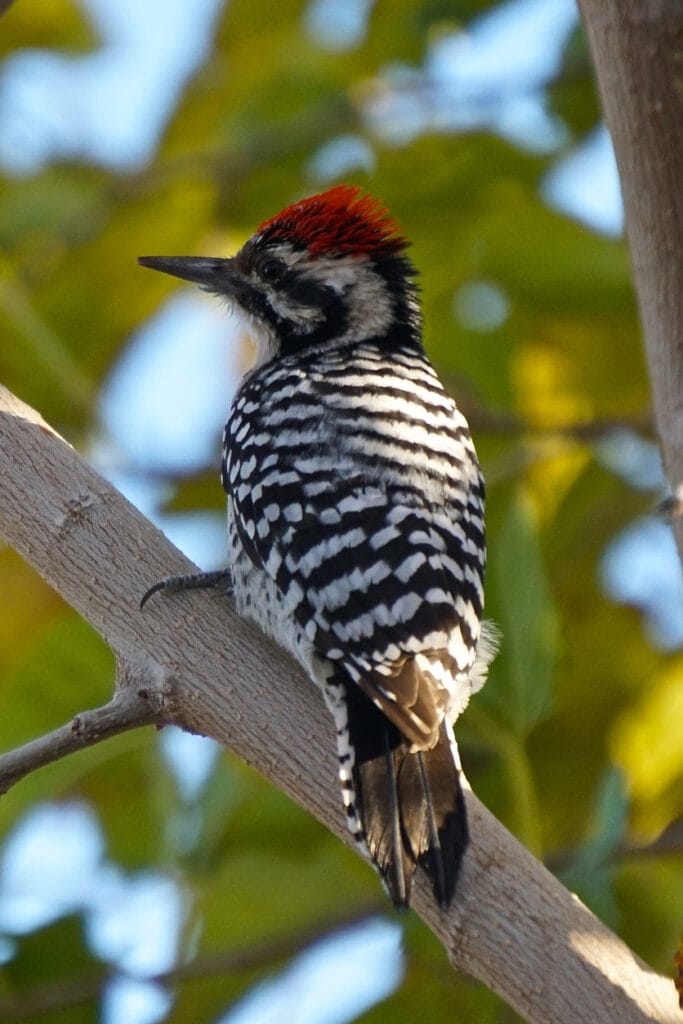
- Scientific Name: Dryobates scalaris
- Length: 6.3 – 7.1 inches
- Weight: 0.7 – 1.7 oz
- Wingspan: 13.0 inches
The Ladder-Backed Woodpecker is a North American woodpecker that can be seen throughout the year in areas in southeast Colorado. They’re most visible from January to March when they’re courting for the mating season.
They’re most active during the early mornings, but they can also be discreet and silent when needed.
Most of them are black and white, with a banded patterning on the back and checkered wings. What differentiates the sexes is the red crown patch that is absent in females.
The Ladder-Backed Woodpeckers eat larvae, insects, and fruits, just like other woodpeckers. They also eat sunflower seeds, nuts, and sugar water to boost their nutrition.
Dry environments, such as deserts, suit them best, though. They usually build their nests in the holes they chisel out of tree trunks.
12. Acorn Woodpecker
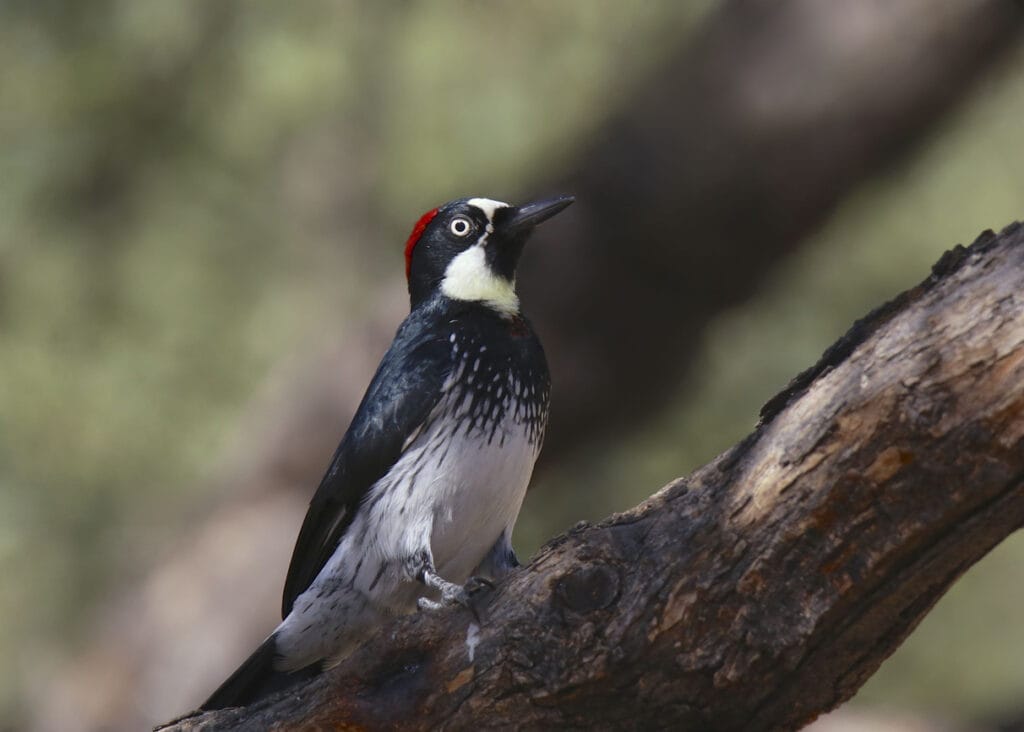
- Scientific Name: Melanerpes formicivorus
- Length: 5 – 9.1 inches
- Weight: 3 – 3.2 oz
- Wingspan: 8 – 16.9 inches
The Acorn Woodpecker is a medium-sized woodpecker native to Oregon, California, and the southwest.
If you spot them once, your odds of a second sighting are fairly high. That’s because they’re known to stay in the same area all year round. However, they’re not the most common species in Colorado.
Top Tip: To identify them, look for a crimson crown. Just keep in mind that the males have bolder red crown plumage.
Acorns make up roughly half of their diet, as the name suggests. Notably, they’re quite good diggers, too. One particularly hard working bird managed to dig a hole that could hold up to 50,000 nuts!
This skill comes in handy during the winter since they use the stored nuts to sustain themselves.
The woodpeckers inhabit evergreen forests on mountainsides. To suit their preferred lifestyle, they reside in cities where acorn is abundant.
Wrap Up
This ends our list of the top 12 woodpeckers in Colorado. Forests are home to the majority of these birds, but you could get lucky and spot them in public parks or on bird feeders.
Most woodpeckers’ behaviors and eating habits are similar. Yet, you’ll still be able to find at least one notable feature to admire in each species.
So, if you happen to see one of these magnificent birds, take a moment to appreciate their beauty.
FAQ
The Red-headed Woodpecker is one of the more common woodpeckers in Colorado, particularly in the Rockies.
To find out where recent sightings of woodpecker have been, try eBird. You can search for the latest sightings or particular species or what has been seen in a certain area.
Try these:
Rocky Mountain National Park – Willamson’s Sapsucker, Three-toed Woodpecker, Red-naped Sapsucker
John Martin Reservoir State Park – Red-bellied Woodpecker
Cottonwood Canyon – Lewis’s Woodpecker, Ladder-backed Woodpecker





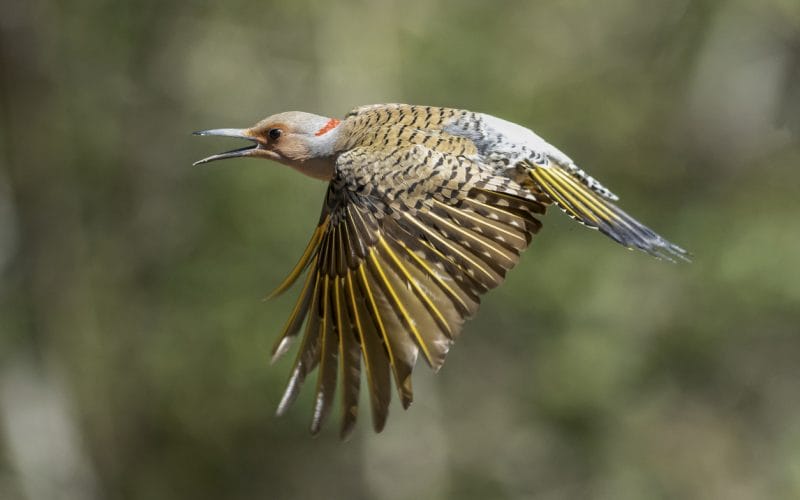

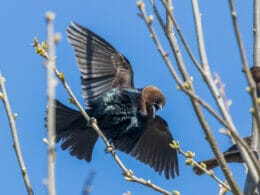


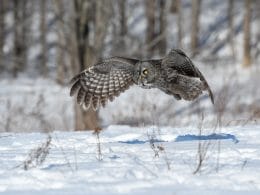
Endangered Red Headed Woodpecker.